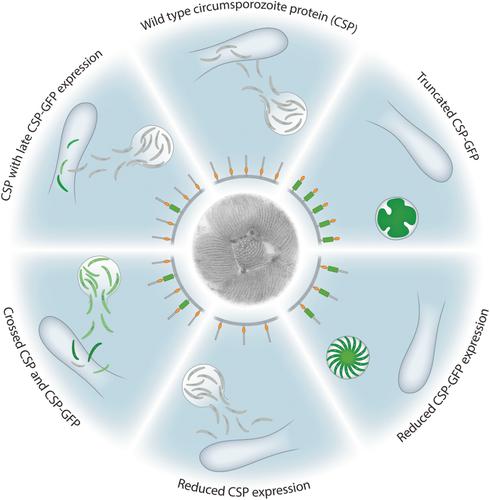当前位置:
X-MOL 学术
›
Mol. Microbiol.
›
论文详情
Our official English website, www.x-mol.net, welcomes your feedback! (Note: you will need to create a separate account there.)
Overcoming the egress block of Plasmodium sporozoites expressing fluorescently tagged circumsporozoite protein
Molecular Microbiology ( IF 3.6 ) Pub Date : 2024-02-23 , DOI: 10.1111/mmi.15230 Carolina Thieleke‐Matos 1 , Kevin Walz 1 , Friedrich Frischknecht 1, 2 , Mirko Singer 1
Molecular Microbiology ( IF 3.6 ) Pub Date : 2024-02-23 , DOI: 10.1111/mmi.15230 Carolina Thieleke‐Matos 1 , Kevin Walz 1 , Friedrich Frischknecht 1, 2 , Mirko Singer 1
Affiliation

|
Plasmodium sporozoites are the highly motile and invasive forms of the malaria parasite transmitted by mosquitoes. Sporozoites form within oocysts at the midgut wall of the mosquito, egress from oocysts and enter salivary glands prior to transmission. The GPI-anchored major surface protein, the circumsporozoite protein (CSP) is important for Plasmodium sporozoite formation, egress, migration and invasion. To visualize CSP, we previously generated full-length versions of CSP internally tagged with the green fluorescent protein, GFP. However, while these allowed for imaging of sporogony in oocysts, sporozoites failed to egress. Here, we explore different strategies to overcome this block in egress and obtain salivary gland resident sporozoites that express CSP-GFP. Replacing the N-terminal and repeat region with GFP did not allow sporozoite formation. Lowering expression of CSP-GFP at the endogenous locus allowed sporozoite formation but did not overcome egress block. Crossing of CSP-GFP expressing parasites that are blocked in egress with wild-type parasites yielded a small fraction of parasites that entered salivary glands and expressed various levels of CSP-GFP. Expressing CSP-GFP constructs from a silent chromosome region from promoters that are active only post salivary gland invasion yielded normal numbers of fluorescent salivary gland sporozoites, albeit with low levels of fluorescence. We also show that lowering CSP expression by 50% allowed egress from oocysts but not salivary gland entry. In conclusion, Plasmodium berghei parasites with normal CSP expression tolerate a certain level of CSP-GFP without disruption of oocyst egress and salivary gland invasion.
中文翻译:

克服表达荧光标记的环子孢子蛋白的疟原虫子孢子的出口阻塞
疟原虫子孢子是由蚊子传播的疟疾寄生虫的高度活动性和侵入性形式。子孢子在蚊子中肠壁的卵囊内形成,在传播前从卵囊中排出并进入唾液腺。GPI 锚定的主要表面蛋白,即环子孢子蛋白 (CSP),对于疟原虫子孢子的形成、流出、迁移和入侵非常重要。为了可视化 CSP,我们之前生成了内部标记有绿色荧光蛋白 GFP 的全长版本的 CSP。然而,虽然这些可以对卵囊中的孢子进行成像,但子孢子未能排出。在这里,我们探索不同的策略来克服这种出口阻塞,并获得表达 CSP-GFP 的唾液腺驻留子孢子。用 GFP 替换 N 末端和重复区域不允许子孢子形成。降低内源位点的 CSP-GFP 表达允许子孢子形成,但不能克服出口阻断。将出口受阻的表达 CSP-GFP 的寄生虫与野生型寄生虫杂交,产生一小部分进入唾液腺并表达不同水平的 CSP-GFP 的寄生虫。从仅在唾液腺入侵后才活跃的启动子的沉默染色体区域表达 CSP-GFP 构建体,产生了正常数量的荧光唾液腺子孢子,尽管荧光水平较低。我们还表明,将 CSP 表达降低 50% 可以使卵囊流出,但不能进入唾液腺。总之,具有正常 CSP 表达的伯氏疟原虫寄生虫耐受一定水平的 CSP-GFP,而不破坏卵囊出口和唾液腺入侵。
更新日期:2024-02-23
中文翻译:

克服表达荧光标记的环子孢子蛋白的疟原虫子孢子的出口阻塞
疟原虫子孢子是由蚊子传播的疟疾寄生虫的高度活动性和侵入性形式。子孢子在蚊子中肠壁的卵囊内形成,在传播前从卵囊中排出并进入唾液腺。GPI 锚定的主要表面蛋白,即环子孢子蛋白 (CSP),对于疟原虫子孢子的形成、流出、迁移和入侵非常重要。为了可视化 CSP,我们之前生成了内部标记有绿色荧光蛋白 GFP 的全长版本的 CSP。然而,虽然这些可以对卵囊中的孢子进行成像,但子孢子未能排出。在这里,我们探索不同的策略来克服这种出口阻塞,并获得表达 CSP-GFP 的唾液腺驻留子孢子。用 GFP 替换 N 末端和重复区域不允许子孢子形成。降低内源位点的 CSP-GFP 表达允许子孢子形成,但不能克服出口阻断。将出口受阻的表达 CSP-GFP 的寄生虫与野生型寄生虫杂交,产生一小部分进入唾液腺并表达不同水平的 CSP-GFP 的寄生虫。从仅在唾液腺入侵后才活跃的启动子的沉默染色体区域表达 CSP-GFP 构建体,产生了正常数量的荧光唾液腺子孢子,尽管荧光水平较低。我们还表明,将 CSP 表达降低 50% 可以使卵囊流出,但不能进入唾液腺。总之,具有正常 CSP 表达的伯氏疟原虫寄生虫耐受一定水平的 CSP-GFP,而不破坏卵囊出口和唾液腺入侵。



























 京公网安备 11010802027423号
京公网安备 11010802027423号